Mostrar el registro sencillo del ítem
Changes to Airborne Pollen Counts across Europe
| dc.contributor.author | Ziello, Chiara | |
| dc.contributor.author | Sparks, Tim H. | |
| dc.contributor.author | Estrella, Nicole | |
| dc.contributor.author | Belmonte, Jordina | |
| dc.contributor.author | Bergmann, Karl C. | |
| dc.contributor.author | Bucher, Edith | |
| dc.contributor.author | Brighetti, Maria Antonia | |
| dc.contributor.author | Damialis, Athanasios | |
| dc.contributor.author | Detandt, Monique | |
| dc.contributor.author | Galán, Carmen | |
| dc.contributor.author | Gehrig, Regula | |
| dc.contributor.author | Grewling, Lukasz | |
| dc.contributor.author | Gutiérrez Bustillo, Adela M. | |
| dc.contributor.author | Hallsdóttir, Margrét | |
| dc.contributor.author | Kockhans-Bieda, Marie-Claire | |
| dc.contributor.author | De Linares, C. | |
| dc.contributor.author | Myszkowska, Dorota | |
| dc.contributor.author | Pàldy, Anna | |
| dc.contributor.author | Sánchez, Adriana | |
| dc.contributor.author | Smith, Matthew | |
| dc.contributor.author | Thibaudon, Michel | |
| dc.contributor.author | Travaglini, Alessandro | |
| dc.contributor.author | Uruska, Agnieszka | |
| dc.contributor.author | Valencia-Barrera, R.M. | |
| dc.contributor.author | Vokou, Despoina | |
| dc.contributor.author | Wachter, Reinhard | |
| dc.contributor.author | Weger, Letty A. de | |
| dc.contributor.author | Menzel, Annette | |
| dc.date.accessioned | 2013-01-15T09:34:28Z | |
| dc.date.available | 2013-01-15T09:34:28Z | |
| dc.date.issued | 2012 | |
| dc.identifier.uri | http://hdl.handle.net/10396/8636 | |
| dc.description.abstract | A progressive global increase in the burden of allergic diseases has affected the industrialized world over the last half century and has been reported in the literature. The clinical evidence reveals a general increase in both incidence and prevalence of respiratory diseases, such as allergic rhinitis (common hay fever) and asthma. Such phenomena may be related not only to air pollution and changes in lifestyle, but also to an actual increase in airborne quantities of allergenic pollen. Experimental enhancements of carbon dioxide (CO2) have demonstrated changes in pollen amount and allergenicity, but this has rarely been shown in the wider environment. The present analysis of a continental-scale pollen data set reveals an increasing trend in the yearly amount of airborne pollen for many taxa in Europe, which is more pronounced in urban than semi-rural/rural areas. Climate change may contribute to these changes, however increased temperatures do not appear to be a major influencing factor. Instead, we suggest the anthropogenic rise of atmospheric CO2 levels may be influential | es_ES |
| dc.format.mimetype | application/pdf | es_ES |
| dc.language.iso | eng | es_ES |
| dc.publisher | Public Library Of Science (PLOS) | es_ES |
| dc.rights | https://creativecommons.org/licenses/by-nc-nd/4.0/ | es_ES |
| dc.source | PLoS ONE 7(4), 1-8 (2012) | es_ES |
| dc.subject | Aerobiología | es_ES |
| dc.subject | Polen | es_ES |
| dc.subject | Europa | es_ES |
| dc.subject | Allergic diseases | es_ES |
| dc.subject | Pollen | es_ES |
| dc.subject | Climate change | es_ES |
| dc.title | Changes to Airborne Pollen Counts across Europe | es_ES |
| dc.type | info:eu-repo/semantics/article | es_ES |
| dc.rights.accessRights | info:eu-repo/semantics/openAccess | es_ES |

